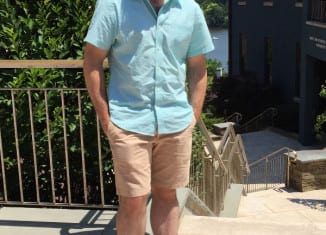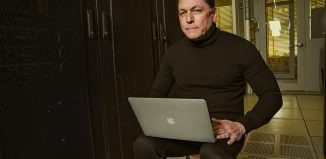CSHL’s Kinney works to decode gene factory
Justin Kinney is like a supervisor at a factory, except that he doesn’t know what the pieces of equipment do.
The only way he can find out is to modify different parts randomly and see how that affects the final product.
An assistant professor at Cold Spring Harbor Laboratory, Kinney’s factory isn’t in a sprawling suburban building but, rather, is genetic material. The regulatory sequence of DNA is the assembly line; binding sites, which attach to proteins, are like the individual machines. The final output of the factory is gene expression.
Kinney is working to understand regulatory sequences of DNA and is trying to develop an ability to see where proteins bind to genes, explore the role proteins play, and see how proteins and genes interact.
“If we do an experiment on a regulatory sequence, we can identify where proteins bind and how much that sequence affects expression,” Kinney said. “The ultimate goal is to be able to predict these things from DNA sequence alone, without having to do an experiment on every specific sequence we are interested in.”
A physicist by training, Kinney works in an area called molecular biophysics, where he tries to figure out what causes one set of reactions to start, stop or continue based on the way different parts involved, such as proteins, DNA, transcription factors or immune cells, interact.
His work has implications for everything from basic science, to improving drug therapies. He’s also working on understanding basic aspects of the immune system.
Recently, Kinney, partnering with Christopher Vakoc, an assistant professor at CSHL, developed a way to identify new drug targets for treating cancer. “We reached out to [Kinney] about a year or so ago to get his insight and assistance” on a project with drug target discovery, Vakoc said. Using Kinney’s skills as a computational biologist and expertise in biophysics, the researchers “co-developed a way to study the Achilles heel of a large number of cancer types,” Vakoc said.
Since the scientists published their research in May, Vakoc said it has “generated a lot of excitement in cancer research” with other scientists trying to find the vulnerabilities of different types of cancer.
Vakoc said Kinney “developed theories of elegant computational tools” that allowed the researchers to gain greater insight into a modern gene editing tool called CRISPR.
Kinney also worked with Thierry Mora and Aleksandra Walczak at the Ecole Normale Supérieure in Paris on an immunology project.
“How antibodies recognize their targets is an immensely interesting question,” Kinney said. The strength of binding that the antibody has for its target determines how well it works.
Kinney and his partners are mapping out how an antibody’s affinity for its target depends on its protein sequence. “That basic relationship has enormous consequences for how well your immune system works,” Kinney said. It also has implications for how well a pharmaceutical company can engineer an antibody as a potential drug, he added.
By changing the genetic sequence, these researchers can explore how strongly the slightly altered antibody will bind to whatever it’s targeting.
Researchers can explore how DNA responds to a signal mechanistically.
“Just by looking at which sequences correspond to which level, we can identify where specific proteins bind to DNA, what these proteins are and how strongly they interact with each other,” Kinney said. “It’s kind of like decoding a message, making changes to that code, and watching to see the reaction.”
These types of studies can help provide a mechanistic understanding of the relationship between a gene sequence and a gene’s function, he said. Once scientists have a clearer picture of that connection, they might be able to predict what effect a mutation in a specific region might have on a gene.
Kinney visited Cold Spring Harbor Laboratory several times before he became a postdoctoral fellow at the lab in 2009. He took courses dating back to 2005.
“I love the environment,” said Kinney. “I fell in love with this place through courses and meetings. It’s an academic resort.”
Kinney met his wife, Antoinette Sutto, when they were in graduate school at Princeton. They lived on the same floor and Sutto was the first person Kinney met in his graduate dorm. Their first date was at a First Chance Dance for graduate students. Sutto is an assistant professor of history at the University of Mississippi.
A resident of Forest Hills, Kinney enjoys the 45-minute Long Island Railroad commute, where he can read and write without a reliable Internet connection.
As for his work, Kinney said he studies how biological information is encoded in DNA, as well as how this information governs how biological molecules function.







